1964 Topps # 67 Tigers TEAM card


Please wander around the website for more info, prices, values & images
on vintage baseball, football, basketball, hockey, sport and non-sports cards.
1956 Adventure cards |


1970 Chemtoy Superballs |

1961 Fleer Baseball Cards |

Cabinet Card Were oversized trading cards featuring paintings issued mostly 1910-1915.
Card Show is a gathering of dealers & collectors looking to buy/sell/trade sports cards and memorabilia.
Card Stock is the material a card is printed on. Usually paper-based, today companies play with the card stock and sometimes it appears to be wood or leather or see-thru acrylic ...
Cello Pack is a card pack whose wrapper is see-thru plastic. Usually the top & bottom cards are seen. Unopened cello packs showing major stars and rookies sell for heavy premiums.
Centering is the balance of the borders: top/bottom & left/right. On perfectly-centered cards, top/bottom borders match as do the left/right borders. Centering is presented as a set of numbers & directions and often included with the grade. Perfectly-centered is "50/50 t/b" AND "50/50 l/r". As centering gets worse, one number increases and the other decreases. For example: 90/10 t/b is considered extremely off-center top to bottom. The numbers add up to 100 (50/50, 60/40, 90/10 ...).
Certificate Of Authenticity (COA) A document used to verify legitimacy of a collectible. NOTE: Keep in mind that COA's are easier to fake then autographs.
Common A card of a non-star player is considered a "Common" as opposed to cards of a star players or specialty/subset cards such as league leaders, teams cards, World Series cards...
Condition (Grade) Centering, corner wear, photo clarity, edges, creases, print flaws ... all combine to determine a card's condition or grade. Along with rarity/scarcity it is the major factor in a card's value.
Crease Defect usually caused by bending the card. Hard to see, or not, a crease lowers the card's grade (VG or lower) and greatly diminishes it's value.
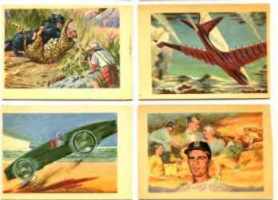 Issued by Gum Products Inc., this 100-card set
covered a variety of subjects. Featuring mostly non-sport like
military or wild life, it also had a few sports related cards.
The most famous being Max Schmeling's card, removed very early from
the set for featuring the Nazi symbol, making it by far the
scarcest and most expensive in the set.
Issued by Gum Products Inc., this 100-card set
covered a variety of subjects. Featuring mostly non-sport like
military or wild life, it also had a few sports related cards.
The most famous being Max Schmeling's card, removed very early from
the set for featuring the Nazi symbol, making it by far the
scarcest and most expensive in the set. 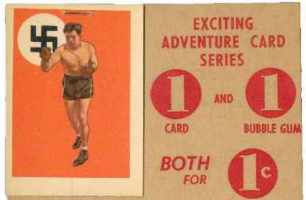
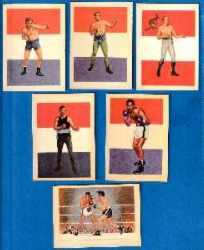
 The 285 player set with 12 per team except Twins, White Sox and A's with 11.
Each "Superball" has the player's photo inside with name,
team, position and Chemtoy inventory number on back.
The 285 player set with 12 per team except Twins, White Sox and A's with 11.
Each "Superball" has the player's photo inside with name,
team, position and Chemtoy inventory number on back.

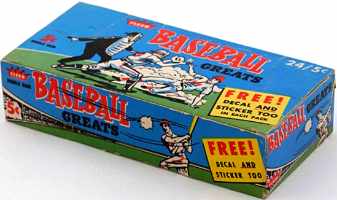
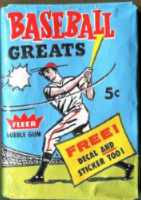 The 1961 Fleer baseball set contained 154 regular-sized cards
honoring careers of Hall-of-Famers Babe Ruth, Walter Johnson,
Lou Gehrig, Honus Wagner, Ted Williams and many lesser
known old-timers.
The 1961 Fleer baseball set contained 154 regular-sized cards
honoring careers of Hall-of-Famers Babe Ruth, Walter Johnson,
Lou Gehrig, Honus Wagner, Ted Williams and many lesser
known old-timers. 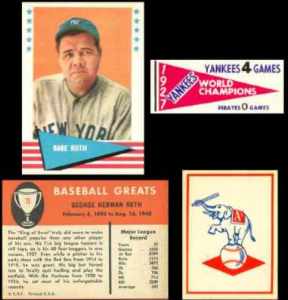 Unfortunately the weak card design and retired players made it a
giant dud with kids and the product was not well received.
Unfortunately the weak card design and retired players made it a
giant dud with kids and the product was not well received. 